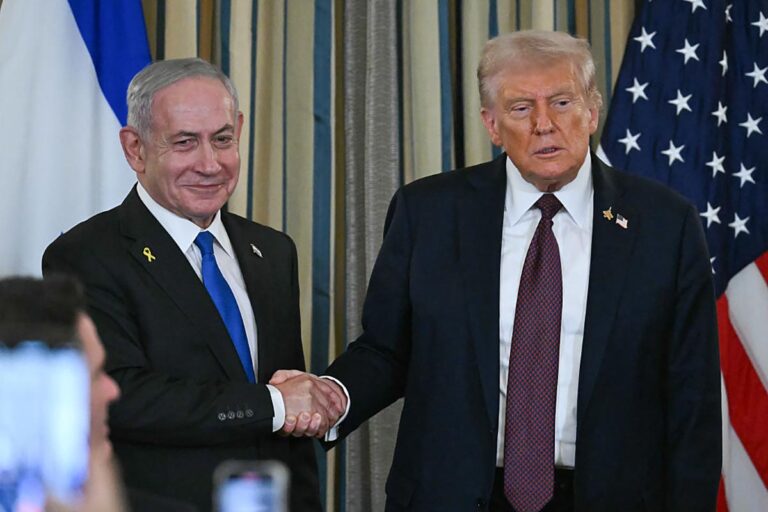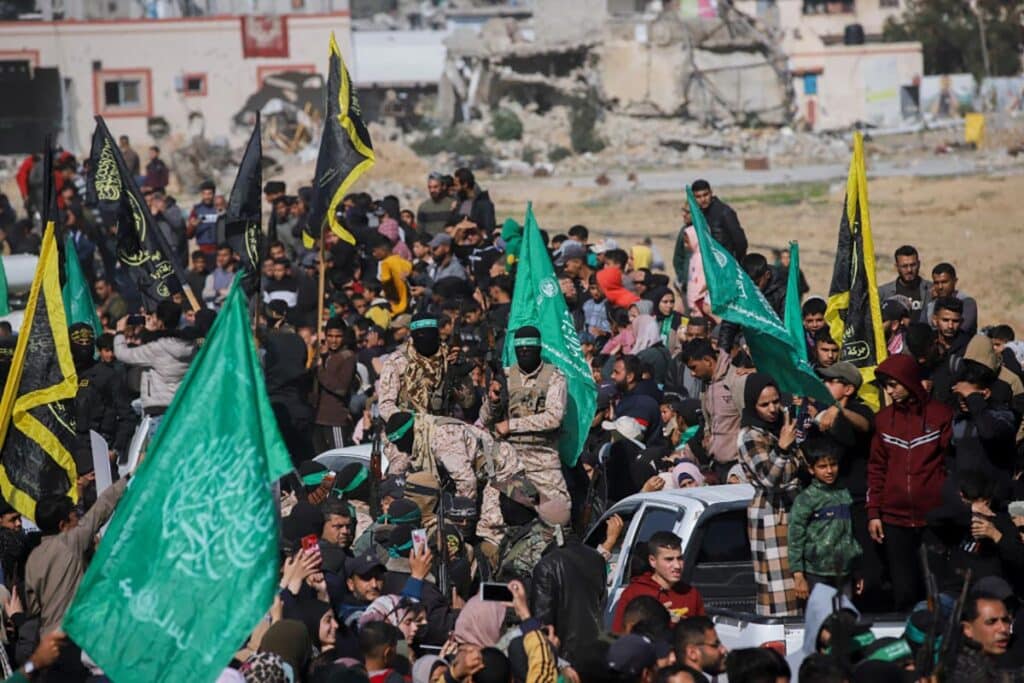
United States President Donald Trump presented his plan to bring about an end to the war in Gaza and release the remaining 48 Israeli hostages alongside Israeli Prime Minister Benjamin Netanyahu on Monday.
Trump called Israel’s agreement to his plan a “historic day for peace.” He stressed that Saudi, Qatari, Jordanian, Turkish, Indonesian, Pakistani, and Egyptian leaders served a role in developing the proposal.
The president added that Arab and Muslim leaders had committed to demilitarize Gaza, and disarm Hamas and all other terrorist organizations in Gaza.
Trump stressed that if the Arab and Muslim states fail to disarm Hamas, Israel will have full U.S. backing “to finish the job of destroying the threat of Hamas.”
Netanyahu announced that he accepted Trump’s plan, emphasizing that it would achieve all of Israel’s war aims. Even with the widespread support behind the deal, though, how likely is it that it could actually end the war?
What is Trump’s plan?
The 20-point proposal includes details about how the war will end and what the future of Gaza will look like.
The plan will have Gaza turned into a “deradicalized terror-free zone that does not pose a threat to its neighbors.”
If both sides approve the agreement, the war will end immediately. Israeli forces will withdraw to an agreed-upon line, and within 72 hours, all hostages will be released.
President Donald J. Trump’s Comprehensive Plan to End the Gaza Conflict:
— Rapid Response 47 (@RapidResponse47) September 29, 2025
1. Gaza will be a deradicalized terror-free zone that does not pose a threat to its neighbors.
2. Gaza will be redeveloped for the benefit of the people of Gaza, who have suffered more than enough.
3. If… pic.twitter.com/veqhr9MW28
In return, Israel will release 250 life sentence prisoners, plus 1,700 Gazans detained since October 7. For every deceased Israeli hostage released, Israel will release the remains of 15 Gazans.
Hamas members who commit to peaceful coexistence will be granted amnesty. Members of the terrorist group who wish to leave Gaza will be provided safe passage.
The flow of humanitarian aid to Gaza will increase, returning to levels that were reached under the last ceasefire agreement. The distribution of aid will be run by the United Nations, the Red Crescent, and other international institutions. The Rafah crossing will be opened under the conditions of the last ceasefire agreement.
A technocratic, apolitical Palestinian committee, including international experts, will be given temporary control of Gaza. It will be responsible for running the day-to-day public services and municipalities.
A “Board of Peace” chaired by Trump will supervise the Palestinian committee. Other officials and heads of state will take part in the Board, including former British Prime Minister Tony Blair. The Board will be in charge of handling the funding for Gaza’s reconstruction.
The proposal also requires the Palestinian Authority to carry out a sweeping reform program in accordance with a peace plan Trump presented in 2020 and with a Saudi-French declaration from July. The deal also calls for an interfaith dialogue to encourage tolerance and peaceful coexistence. Once the reform is completed, a pathway may open to establishing a Palestinian state.
The plan additionally includes economic goals for securing the economic future of Gaza, including the establishment of a special economic zone.
It also stresses that no Palestinians will be forced to leave Gaza, and any who do leave will be free to return. Palestinians will be encouraged to stay.
Hamas and the factions allied with it will have to agree to have no role in governing Gaza. The Strip will be entirely demilitarized, and all terrorist infrastructure will be destroyed. The weapons in Hamas’ possession will be handed over to independent monitors through an agreed-upon process.
The U.S. will work with Arab and international partners to develop an “International Stabilization Force” (ISF) that will secure Gaza, train Palestinian police, and prevent weapons smuggling into the Strip.
As the plan progresses, the IDF will gradually withdraw completely from Gaza, handing over control to the ISF.
If Hamas rejects the plan or delays its implementation, the plan will move forward in the areas handed over to the ISF by the IDF.
A plan that is easier said than done
While Trump and Netanyahu expressed optimism that the new plan could end the war, many pieces still need to fall into place for it to succeed.
Most importantly, Hamas hasn’t given its approval. Qatar and Egypt only provided Hamas with a copy of the plan after the press conference on Monday. Hamas officials responded with skepticism.
Ismail Al-Thawabta, the director of the Hamas-run Government Media Office in Gaza, rejected Trump’s plan, saying it represents “an attempt to impose a new trusteeship that legitimizes the Israeli occupation and strips our Palestinian people of their national, political, and human rights.”
Thawabta added that any proposal that would have Gaza demilitarized and run by an international administration would be “categorically rejected.”

Hamas official Mahmoud Mardawi said on Monday evening that the movement hadn’t yet reviewed the Trump plan, but expressed skepticism as it is “close to the Israeli position.” Mardawi added that Hamas would examine the American proposal, but stressed that the terrorist group would not accept “any proposal that does not include self-determination for the Palestinian people and protect them from massacres.”
Mardawi also described the announcement of Trump’s plan as “an attempt to suppress the international momentum and recognitions of the [Palestinian] state.”
The Palestinian Authority, for its part, welcomed Trump’s plan, emphasizing that it was committed to holding elections within one year of the war’s end and establishing a modern, democratic, unarmed Palestinian state. The PA added that it was also committed to reforming its education system in accordance with standards set by the United Nations Educational, Scientific and Cultural Organization (UNESCO) within two years and abolishing the pay for slay program in which Palestinian terrorists are paid a stipend for attacking Israelis.
Even if Hamas accepts the deal, that won’t be the end of the story, though.
First, the details of the plan need to be ironed out, and the devil is always in the details. Who will serve on the Palestinian committee and the international security force in Gaza? Who will determine when the Palestinian Authority has completed enough reforms to take over Gaza? If there aren’t concrete milestones, what’s to stop the Palestinians or the supervising committee from declaring the reform completed when it isn’t, or Israel from deciding the reform hasn’t gone far enough, no matter how far it goes?
There are other questions too. How will the process of handing over control to the international force take place? If Hamas doesn’t agree to the deal and it moves forward regardless, what happens to the hostages? At what point will Hamas be considered destroyed enough in each area that Israel still controls for the international force to take over?
Both Israel and Hamas could also argue at any point that the other side isn’t upholding the agreement and decide to violate it themselves, as has happened repeatedly in the past.
Hamas also isn’t the only armed group in Gaza. If these other groups refuse to give up their arms, who takes care of them: Israel or the international force?
Past peacekeeping forces have failed because of questions like these. In Lebanon, both the U.N. and Lebanon exploited vague provisions in the mandate of the peacekeeping mission there to avoid having to actually disarm Hezbollah.
Some potential issues from Israel’s side also appeared during the press conference on Monday. Netanyahu said that Israel would retain security responsibility for the foreseeable future and that neither Hamas nor the PA would govern Gaza.
These two points could contradict the Trump plan, which stated that Israel would not retain security responsibility of the entire Strip; it would only maintain a security perimeter along the Israel-Gaza border. The plan also sets the goal of eventually bringing Gaza under the control of the PA, an aim that Netanyahu appeared to reject in his statement. The prime minister acknowledged that the deal plans for the PA taking over if it undergoes serious reforms, but stressed that “the vast majority of Israelis have no faith that the PA leopard will change its spots.”
“Instead of Hamas isolating us, we turned things around and isolated Hamas”
Netanyahu described his visit to Washington as “historic,” saying, “Instead of Hamas isolating us, we turned things around and isolated Hamas.”
“Now the entire world, including the Arab and Muslim world, is pressuring Hamas to accept the conditions that we set together with President Trump,” Netanyahu added. He reiterated that he did not agree to accept the creation of a Palestinian state.
The plan states that after all of its steps are completed, “the conditions may finally be in place for a credible pathway to Palestinian self-determination and statehood” and that the U.S. recognizes self-determination and statehood as “the aspiration of the Palestinian people.” That one word, “may,” leaves room for interpretation, as it means that self-determination and statehood aren’t necessary conditions for the plan.
Arab and Muslim leaders back Trump plan, say they’ll ramp up pressure on Hamas
The foreign ministers of Qatar, Jordan, the United Arab Emirates, Indonesia, Pakistan, Turkey, Saudi Arabia, and Egypt welcomed Trump’s plan on Monday.
The ministers affirmed that they were ready to work with the U.S., Israel, and the Palestinians to finalize the agreement and ensure its implementation. They also stressed that any deal would need to create “a path for a just peace on the basis of the two-state solution, under which Gaza is fully integrated with the West Bank in a Palestinian state in accordance with international law.”
Sources in Qatar told The Jerusalem Post and Sky News Arabia on Monday that Qatar could persuade Hamas to agree to give up its weapons. How exactly it planned to do so wasn’t immediately clear. Some past proposals have included a plan to have Hamas “freeze” its weapons, handing them over to a mediator who would in turn keep them in storage.
Netanyahu apologizes for Qatar strike
During a meeting with Trump before the press conference, Netanyahu and Trump held a discussion with Qatari Prime Minister Mohammed bin Abdulrahman bin Jassim al-Thani, in which they agreed to establish a trilateral mechanism between the three states aimed at enhancing coordination, improving communication, resolving mutual grievances, and strengthening collective efforts to prevent threats. The three state leaders additionally discussed a proposal to end the war in Gaza.
Netanyahu also held a conversation with al-Thani and apologized for Israel’s strike on Hamas leaders in Doha earlier this month. Netanyahu promised that the Jewish state would not try to strike Qatar again and expressed regret for the death of a Qatari security officer in the strike.
Qatar had demanded that Israel apologize for the strike as a condition for its continued involvement in efforts to secure a deal to end the war in Gaza.
The apology sparked outrage among both right- and left-wing politicians in Israel. Many Israeli officials stressed that Qatar still hadn’t categorically condemned the October 7 massacre nor apologized for its role in providing a safe haven and funding for Hamas.


